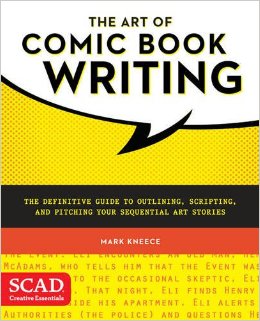One of the most puzzling, yet exciting formats for writers is the graphic novel. That’s the new name for comic books, or telling stories in a set of illustrated panels. In some writing a graphic novel is like writing a movie script, except the images are still instead of moving.
Writing a graphic novel comes with lots of questions.
- What’s the standard format for a graphic novel manuscript?
- Do you have to provide the illustrations?
- How do you decide how many panels per page?
- How do you pace a story across a couple pages?
Many of these questions relate also to writing children’s picture books, which are a combination of text and illustrations.
Finally, I have a resource I’d like to recommend to answer these questions: The Art of Comic Book Writing: The Definitive Guide to Outlining, Scripting, and Pitching Your Sequential Art Stories by Mark Kneece. Available as Kindle or paperback.

NOTE: I didn’t receive a review copy on this book. I just found it at my local library and was captivated.
Kneece has taught comic book writing at the Savannah College of Design for over two decades and his expertise and experience shows. He has created eight graphic novel adaptations of The Twilight Zone, and has published numerous graphic novels and comics, including work for Hellraiser, Verdilak, Alien Encounters, Batman: Legends of the Dark Knight, and The Spirit.
Comics Tell Great Stories
Kneece begins with an emphasis on the story that you want to tell with hints on how to develop a story past a gag. You’ll see actual examples of a formatted script. Next comes a detailed look at a single page and how a story flows across the page. Templates for a 5-panel, 6-panel, 9-panel and 12-panel bring the page to life. Rough sketches illustrate Kneece’s points about how a story flows across these different panels.
With the basics out of the way, the book gets really interesting digging into dialogue, text, characters, pacing and more. This is a fantastic book for those writing picture books because everything he says here applies to both comics and children’s picture books.
I LOVE the pacing chapters.
In Part 1, pp125-127, there’s a great example of revising for pacing, emphasis and impact. The question is where to expand the story with more details and where to compress the story for impact. This is one of the best illustrations of pacing an illustrated story that I’ve seen.
And then, in Part 2, there’s a great example of a story with a boy hears an ice cream truck. The top row is 4 panels.
Panel 1: A boy is playing with a toy rocket. A few musical notes intrude into the frame.
Panel 2: grass and musical notes
Panel 3: grass and musical notes that are trending upward
Panel 4: musical notes dance past the trunk of a large tree.
In other words the 4 panels operate more like one large panel that spans four panels. But the choice to create four panels – a quad-tych, if you will – adds energy to the story. It’s brilliant.
If you’re an illustrator of children’s books, you need to study this book. If you write children’s picture books, you need to study this book. Comic books writers and illustrators, it’s definitely the best text I’ve seen on the topic. Highly recommended.